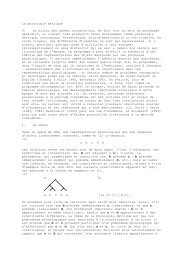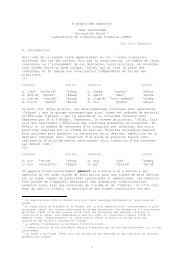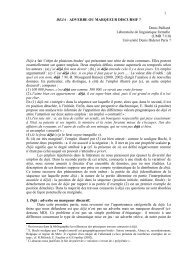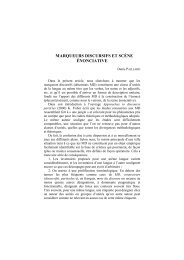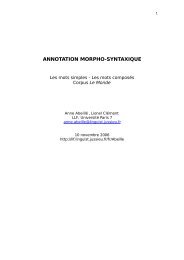CV as the only syllable type Jean Lowenstamm
CV as the only syllable type Jean Lowenstamm
CV as the only syllable type Jean Lowenstamm
Create successful ePaper yourself
Turn your PDF publications into a flip-book with our unique Google optimized e-Paper software.
preceding section to non-templatic morphological systems. In Section 4, I<br />
examine <strong>the</strong> c<strong>as</strong>e of Danish, arguing that its "virtual" geminates, <strong>as</strong> evidenced by<br />
stöd, support <strong>the</strong> claim that <strong>the</strong> syllabic structure of all languages reduces to <strong>CV</strong>.<br />
In Section 5, I return to <strong>the</strong> representational issue brought up in this introductory<br />
section and briefly sum up <strong>the</strong> main points of <strong>the</strong> paper.<br />
1 Branching constituents and <strong>the</strong>ir reanalysis<br />
A closed <strong>syllable</strong>, tak, analyzed in cl<strong>as</strong>sical f<strong>as</strong>hion appears <strong>as</strong> <strong>the</strong> first<br />
constituant of <strong>the</strong> hypo<strong>the</strong>tical form in (2a). I propose that <strong>the</strong> word [takti] be<br />
reanalyzed <strong>as</strong> in (2b), i.e. <strong>as</strong> a sequence of three light open <strong>syllable</strong>s, <strong>the</strong> second<br />
of which h<strong>as</strong> an empty nucleus.<br />
(2)<br />
a. b.<br />
closed <strong>syllable</strong><br />
reanalysis<br />
[C V C][C V] [C V][C V][C V]<br />
| | | | |<br />
t a k t i<br />
| | | | | |<br />
t a k ø t i<br />
From <strong>the</strong> vantage point of <strong>the</strong> reanalysis in (2b), <strong>the</strong> grammaticality of an<br />
object such <strong>as</strong> surface [takti] will be <strong>as</strong>sessed in terms of <strong>the</strong> distribution of<br />
empty nuclei enforced in <strong>the</strong> language: 2 if empty nuclei are tolerated, <strong>the</strong><br />
language will display what appears to be consonant clusters; if empty nuclei are<br />
not tolerated, <strong>the</strong> language will exhibit strict alternances of consonants and<br />
vowels.<br />
Geminate consonants cl<strong>as</strong>sically analyzed <strong>as</strong> in (3a) will be argued to<br />
justify a representation such <strong>as</strong> in (3b), with three light <strong>syllable</strong>s. The salient<br />
feature of (3b) is <strong>the</strong> presence of <strong>the</strong> V position straddled by <strong>the</strong> geminate.<br />
(3)<br />
a. b.<br />
geminate consonant<br />
[C V C] [C V]<br />
reanalysis<br />
[C V][C V][C V]<br />
| | \ / |<br />
b a t a<br />
| |<br />
b a<br />
\ / |<br />
t a<br />
Much <strong>as</strong> (3a) can be viewed <strong>as</strong> a special c<strong>as</strong>e of (2a), (3b) is, essentially, a<br />
special c<strong>as</strong>e of (2b). One and <strong>the</strong> same phenomenon, Cl<strong>as</strong>sical Arabic<br />
2 The distribution of empty nuclei subsumes observations collected under <strong>the</strong> label "<strong>syllable</strong><br />
inventory of a language". It is regulated by <strong>the</strong> Principle of Proper Government. See Kaye et al.<br />
(1990) and Scheer (1996) for discussion.



